Text


Stone Statue from Tlaxcala, Mexico dated between 1000-1500 on display at the Weltmuseum in Vienna, Austria
The confederation of Tlaxcala contributed substantially to the Spanish victory over the Aztecs. Today's Mexican State of Tlaxcala continues to emphasise its former relationship to the Spanish crown and the Hapsburgs. Monograms of Spanish kings and the golden banner with a black eagle are depicted in the state's coats of arms. According to the viewpoint of the inhabitants of Tlaxcala, their ancestors defeated the Aztecs with the support of Spain. Later Tlaxcala took part in the Spanish conquests in northern Mexico, Guatemala and the Philippines.
Photographs taken by myself 2022
2 notes
·
View notes
Text
Flag of the Aztec Empire
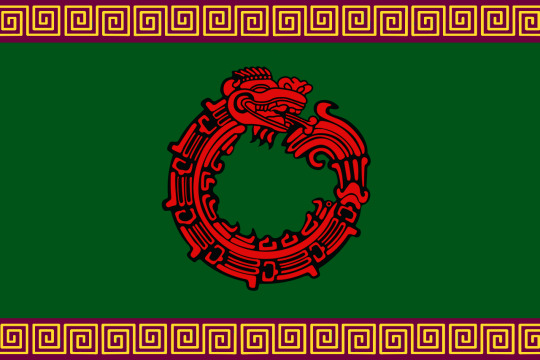
This is the flag of the Aztec Empire. It comes from a world where the Aztecs defeated Cortez and his troops. Smallpox still ravaged the Aztecs, but due to the more limited exposed they were able to recover by the time the Spanish sent additional expeditions. It soon become obvious that the empire would need to reform itself if it was going to survive the European colonization of the Americas. The debate around these reforms leads to social upheavals and rebellions. The empire ultimately survived, but with a Tlaxcalan ruling dynasty. The Tlaxcalans, always one of the more reform minded peoples of the empire, set about instituting serious reforms. The first reform was the structure of the empire. The provinces became much more centralized in their organization. The emperor still ruled over all, but each province sent a group of delegates to represent the needs of the province in a special council in Tenochtitlan. The priests and priestesses also began to slowly phase-out human sacrifice from the traditional religion of the Aztecs. Trade relations were established with multiple European nations both to gain access to European technology and to play the various powers off of each other. For the next few centuries the Aztecs would be prosperous and would have good relations with their neighbors. They provided troops to the Federated Provinces of Cabotia during their rebellion against the British Empire. To this day the two nations remain close allies to this day. The Aztecs also maintained good relations with the Incan Empire, which also managed to avoid European conquest. The Aztecs went on to expand their territory to stretch from the American Southwest to the tip of Panama, and even managed to nab a few islands of the Caribbean. The next major wave of reforms occurred during the 19h century. The Aztecs, much like Japan during the Meiji Restoration, underwent a Westernization process. Though from the Aztecs points of view the term would more accurately be Easternization. Industrialization began to take off, and Western clothing and customs were slowly introduced to improve relations with the great powers of Europe. However, the Aztecs did not completely turn their backs on their traditional culture. Aztec clothing still remains very colorful and incorporates many traditional designs, and nose rings are still somewhat popular for men and women. More traditional clothing is usually reserved for special ceremonies and occasions, such as religious festivals and the emperor's birthday. The Aztecs also still worship their old gods, and many temples and shrines can be found throughout the empire. On the other hand, secularism is on the rise, and many people only perform the old rituals out of habit and tradition. What was once an empire imfamous for its bloodlust is today known as a thriving center of technology and innovation. The flag features the colors red and green, which are traditional Aztec colors. The maze pattern is a common feature in Aztec artwork. The red snake is the feathered serpent god Quetzalcoatl, god of the winds and one of the most important gods in the Aztec pantheon.
Link to the original flag on my blog: https://drakoniandgriffalco.blogspot.com/2016/11/flag-of-aztec-empire.html?m=0
#alternate history#alternate history flag#alternate history flags#flag#flags#Aztec Empire#aztec#Aztecs#Nahuas#Nahua#Mexica#Mexico#indigenous#indigenous people#Triple Alliance#Tlaxcala#Tlaxcalans#Flag of the Aztec Empire#alt history#vexillology
94 notes
·
View notes
Note
Hello, I want to discuss something with you regarding your post about Spain being a “father figure” to your Mexico and how this is not a very good take.
- You do realize that Cortez’s brief stay in Tenochtitlán, while “pacifist” was the beginning of what would be one of the most disgusting acts of violence against the Mexica peoples and later lead to the colonization of Mexico? Cortez and his men where later ran out during “Noche Triste” where they had to retreat and join forces with the Tlaxcalans, Otomi and several other tribes who where on bad terms with the Mexica just to sack and burn Tenochtitlán.
- Making your Mexico Spain’s kid (regardless of whether or not they’re biologically related) is unintentionally romanticizing the colonization and brutality the Spanish committed against the Mexica peoples. I’m not denying the Spanish influence Mexico has, I’m Mexican myself. I’m simply saying that colonialism shouldn’t be romanticized.
If you want me to elaborate on any of these points I will do so gladly. I mean no ill towards you, I simply want you to maybe take another look at how you write these character’s relationship.
I don't know why it won't let me publish it in Spanish… but here I'm going to put images of what it says in Spanish and if you want, you can read the English translation at the end!
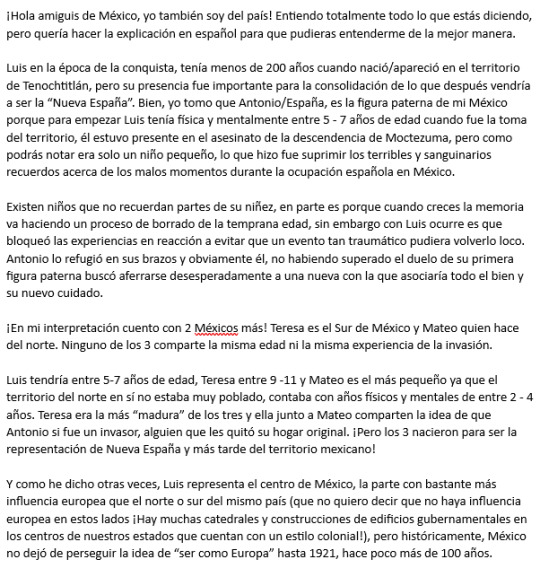
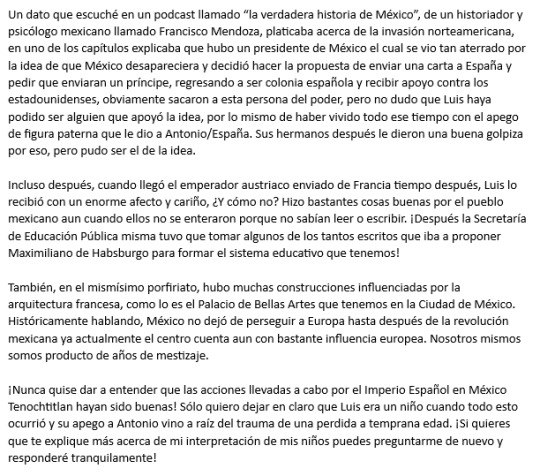
~~~~~~
Here is the English translation!
I'm not a fluent English speaker but I try to use it for the community on Tumblr! <3
Hello buddy from Mexico, I'm from Mexico too! I totally understand everything you are saying, but I wanted to make the explanation in Spanish so you could understand me in the best way.
Luis at the time of the conquest, he was less than 200 years old when he was born/appeared in the territory of Tenochtitlan, but his presence was important for the consolidation of what would later become "New Spain". Well, I take Antonio/Spain, to be the father figure of my Mexico because to begin with Luis was physically and mentally between 5 - 7 years old when the territory was taken, he was present at the murder of Moctezuma's offspring, but as you may notice he was just a little boy, what he did was to suppress the terrible and bloody memories about the bad times during the Spanish occupation of Mexico.
There are children who do not remember parts of their childhood, partly because as you get older your memory goes through a process of erasure from an early age, but with Luis he blocked out the experiences in reaction to prevent such a traumatic event from driving him mad. Antonio sheltered him in his arms and obviously he, not having overcome the mourning of his first father figure, sought desperately to cling to a new one with whom he would associate all the good and his new care.
In my interpretation I have 2 more Mexicans! Teresa is the South of Mexico and Mateo plays the North. None of the 3 share the same age nor the same experience of the invasion.
Luis would have been between 5-7 years old, Teresa between 9 -11 and Mateo is the youngest as the northern territory itself was not very populated, he had physical and mental years between 2 - 4 years old. Teresa was the most "mature" of the three and she and Mateo share the idea that Antonio was an invader, someone who took away their original home, but all three were born to be the representation of New Spain and later of the Mexican territory!
And as I have said before, Luis represents the centre of Mexico, the part with much more European influence than the north or south of the same country (not to say that there is no European influence in these parts. There are many cathedrals and government buildings in the centres of our states that have a colonial style!), but historically, Mexico did not stop pursuing the idea of "being like Europe" until 1921, a little more than 100 years ago.
A piece of information I heard in a podcast called "the true history of Mexico", by a Mexican historian and psychologist called Francisco Mendoza, he talked about the American invasion, in one of the chapters he explained that there was a president of Mexico who was so terrified by the idea of Mexico disappearing and decided to make a proposal to send a letter to Spain and ask them to send a prince, Obviously this person was removed from power, but I don't doubt that Luis could have been someone who supported the idea, because he lived all that time with the father figure attachment he gave to Antonio/Spain. His brothers later gave him a good beating for that, but he could have been the one behind the idea.
Even later, when the Austrian emperor arrived from France some time later, Luis received him with enormous affection and affection, and how could he not? He did a lot of good things for the Mexican people even though they didn't know about it because they couldn't read or write, and later the Ministry of Public Education (SEP in Mexico) itself had to take some of the many writings that Maximilian of Habsburg was going to propose to form the educational system that we have!
Also, in the Porfiriato itself, there were many buildings influenced by French architecture, such as the Palacio de Bellas Artes in Mexico City. Historically speaking, Mexico did not stop chasing Europe until after the Mexican Revolution, and nowadays the city centre still has a lot of European influence. We ourselves are the product of years of miscegenation.
I never meant to imply that the actions taken by the Spanish Empire in Mexico Tenochtitlan were good! I just want to make it clear that Luis was a child when all this happened and his attachment to Antonio came from the trauma of a loss at an early age. If you want me to explain more about my interpretation of my children you can ask me again and I will answer calmly! ✨
#hetalia#aph mexico#latin hetalia#hws mexico#oc#aph spain#hws spain#antonio fernandez carriedo#luis hernández
9 notes
·
View notes
Text
~~The Iztaccihuatl and Popocatépetl volcanoes, and their legend~~
"The Popocatépetl and Iztaccíhuatl volcanoes are the second and third highest mountains in Mexico and one of its most iconic natural landscapes."
A legend tells that these two mountains represent a maiden and a young Tlaxcalan warrior; Popocatépetl and Iztaccíhuatl. Iztaccihuatl was the most beautiful Tlaxcalan princess ever seen and she deposited her love in the young Popocatépetl, one of the most handsome and brave warriors of her people.
They say that before leaving for the war in which the Tlaxcalans were immersed against their staunch enemies, the Aztecs, Popocatépetl asked the chief of his town for the hand of the princess Iztaccihuatl. He granted it to her, but on condition that he returned safely from the war to marry her.
Thus, the warrior went to battle while the princess awaited the return of her love. However, the viperine tongue of a jealous rival of Popocatéptl mediated in bad faith, deceiving the princess and informing her that her lover had died in combat.
Dragged by her inconsolation and grief, unknowing herself a victim of her deceit, she calls herself that beautiful princess who died of sadness for the loss of her lover.
A short time later, Popocatépetl returned victorious from his company willing to marry Iztaccíhuatl, however upon his arrival he received the unfortunate news of his death.
For several days and nights, they say that the young man, despondent, wandered the streets until he found a way to honor the great love they both professed, and it was so that he ordered the construction of a great tomb under the sun, piling up 10 hills to raise a huge mountain.
Once built, he took the inert body of his princess, and laying her down on the top of the mountain, he kissed her for the last time and then, smoking torch in hand, kneeled to watch her sleep eternally. Since then they have stayed together. One in front of another.
Over time the snow covered their bodies that would become two huge volcanoes that will remain unchanged until the end of time.
That is why, when the warrior Popocatépetl remembers his beloved Iztaccihuatl, his heart, which keeps the fire of eternal passion, trembles, and his torch catches fire again.
...That is why, even today, the Popocatépetl volcano continues to spew smoke vents.
~Source of text~ (spanish)
5 notes
·
View notes
Text
Why on earth do Tlaxcalan houses not have heating?? I get that stereotypically Mexico is hot, but those who live here, in the mountains, surely realise that's not always the case.
0 notes
Note
No worries, I’m more than glad to answer your own question lol.
I’m going to reference my own Oc’s to help explain my point, I hope you don’t mind.
- I have both an Aztec and Tenochtitlan Oc’s that use the denomination “Mexica” the main reason I do this is because;
1) What we understand as “Aztec” history is mostly referencing Mexica history. The Mexica where the last Nahuatl speaking tribe to leave their homeland known as “Aztlán” hence, where “Aztec” comes from. All Nahuatl speaking city states that became a part of the Triple Alliance’s sphere of influence are referred to as “Aztecs”. The only ones this did not apply to where the Tlaxcalans.
2) Tenochtitlan was the main metropolis of the civilization being the “capital” of the empire, however it has a culture and history that is different than that of the other city states. Making it “unique” in that aspect.
Both of these Oc’s are Mexica, but they hold different responsibilities. My Tenochtitlan is more like the political face of the Mexicas while the one I refer to as my Aztec is more representative of the culture itself. However if you want to make your Aztec also a Tenochtitlan, that works fine.
If you want good websites to look into the history of the Aztecs and other MesoAmerican groups, I recommend INAH (Instituto National de Antropología y Historia) which is Mexico’s official history and culture ministry. I also recommend Mexicolore, they do a good job of delving deeper into the culture!
Thank you for the clear up ! It was always something that confuse me so i guess i know better now. Also mexicolore was one of the sites i used so i'm glad it's legit ^^
0 notes
Text
Keep Your Friends Close; Keep Your Altepetl Closer (3/3)
All empires, regardless of power or influence, inevitably collapse. A widely-held misconception regarding The Aztec Empire is that the Aztecs fell victim to Spanish conquistadors, leading to the empire's downfall. Spanish conquistadors did play a role in Aztec collapse, but Spanish victory over the Aztecs was made possible by decades of altepetl attacks, slowly weakening the empire's military forces. Let's explore the role of altepetl in The Aztec Empire's decline, fueled by altepetl's religious resentments.

Conquering neighboring territories caused the Aztecs to receive divine praise from their gods and goddesses. Additionally, conquering neighboring territories caused the Aztecs to gain military power through recruitment of men from allied and conquered altepetl. As the Aztec military grew stronger, the civilization became increasingly inspired by both Huitzilopochtli, god of war, and personal motives to expand the empire. This expansion forced altepetl to produce routine material and human sacrifices to the Aztecs for the benefit of Aztec gods and goddesses. The Aztec Empire, on many occasions, stole slaves and prisoners from nearby tribes for ritualistic purposes. Consequently, many altepetl harbored religious resentments towards the Aztecs, and attempted to rebel against Aztec control. During the reign of Aztec ruler Montezuma II from 1503 to 1520, both the empire and altepetl rebellions were at their peaks.
Source: Laack, Isabel. Aztec Religion and Art of Writing: Investigating Embodied Meaning, Indigenous Semiotics, and the Nahua Sense of Reality. Brill, 2019. Print.

Image Source: “Montezuma II.” Wikipedia, Wikimedia Foundation, 2023, https://en.wikipedia.org/wiki/Moctezuma_II
Despite constant rebellions from altepetl, Montezuma II defeated neighboring tribes' attempts to gain sovereignty. Altepetl rebellions, however, significantly weakened The Aztec Empire through exhaustion of Aztec resources and military forces. Shortly after the altepetl rebellions, Spanish conquistador Hernán Cortez attempted to invade The Aztec Empire. Unstable relations between the Aztecs and conquered altepetl gave Cortez the opportunity to form alliances with altepetl, most notably the Tlaxcalans, known as long-term enemies of the Aztec, and strong war fighters. The Tlaxcalans were largely responsible for Cortez's later victory over The Aztec Empire. Towing a large army of angry natives into the Aztecs' capital city of Tenochtitlan, Cortez quickly imprisoned Montezuma II. The ruler eventually submitted to Spanish forces and, in doing so, lost the respect of the Aztec civilization. Spanish accounts claim Aztecs living in Tenochtitlan bombarded Montezuma II with stones and arrows during Montezuma II's frugal attempts to negotiate peace, causing Montezuma II to suffer fatal wounds. Aztec accounts claim Cortez murdered Montezuma II, causing the conquistador's regime to be nearly destroyed in exiting Tenochtitlan by the Aztec regime.
Source: Read, Kay Almere. Time and Sacrifice in the Aztec Cosmos. Indiana University Press, 1998. Print.
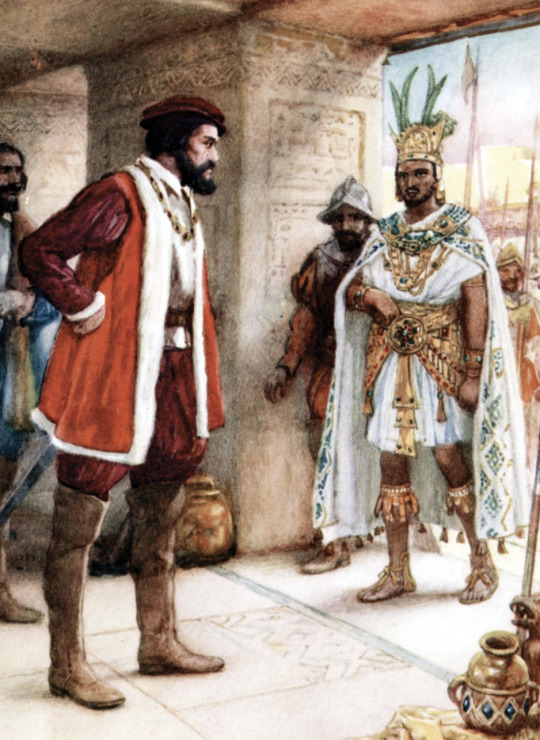
Image Source: Britannica Editors. “Montezuma II.” Encyclopædia Britannica, Encyclopædia Britannica, Inc., 2023, https://www.britannica.com/biography/Montezuma-II
The exact demise of Montezuma II remains uncertain. The role of religion in The Aztec Empire's decline and collapse remains absolute. In fact, the role of religion remains evident in all stages of the empire's lifespan. Religious ideals fueled constant need for war that subsequently expanded Aztec territory, religious allegiance gave the Aztecs leverage to maintain control over conquered altepetl, and religious resentments led to a weakening of The Aztec Empire, aiding overrule of Montezuma II by Spanish forces.
#imperialism#ancient history#history#colonialism#imperialists#aztecs#aztec empire#spanish#conquistadores#cortez#mythology#religion#mesoamerica#the americas#mexico#spain#all great things must come to an end#don't mess with altepetl#vulnerability is hard#embarrassing ends#nice guys finish first
1 note
·
View note
Video
youtube
Avatar vs Princess Mononoke: How to have a message youtube comments
"To see with eyes unclouded by hate and try to slow the cycle of violence" You need a megaphone and the whole of reddit held hostage in a room or hell the whole of humanity held in a room to listen to this sermon. When addressing the anti-colonialism narrative, I love bringing up the Tlaxcalans. You know, the people that were systematically harvested for human sacrifices. They joined the Spanish almost instantly to help take down the Aztecs. There were more Tlaxcalan fighters than Spanish! Conquistadors vs Aztecs is two evil empires fighting, not the innocent Aztecs being attacked by evil Spaniards
Similar things happened here in the Inkan Empire. Several tribes or descendents of tribes under Inka rule immediately joined the Spanish. Some people view them as traitors, but it was their path to freedom from a tyrannical regime
To be fair with The Last Airbender, the show ended up subverting the whole narrative it established in the beginning with the Fire Nation being cartoon villains. In season 2, we were introduced to Jet, who ended up being a fanatical "freedom fighter" willing to slaughter a whole town of innocent civilians, and the Dai Lee of Ba Sing Se, which was more or less just the Gestapo with a little bit of KGB/CIA mixed in with that MK Ultra type s**t they were doing. And season 3 spent nearly its entire length giving perspective from the Fire Nation's side, showing us that there were plenty of good people within the Fire Nation living under a totalitarian regime, as well as of course giving us the conclusion of Zuko's redemption arc. We also gotta remember that everyone's favorite Uncle Iroh was once a Fire Nation general that besieged Ba Sing Se, and it was only the death of his son (a death that occurred during the said siege he was responsible for) that led to his disillusionment with the Fire Nation leadership and the war it was waging.
“San is just like Jake Sully, a human that rejected their humanity and sided wholeheartedly with nature. -Except she’s in the wrong.” — That completely blew my mind, and I will forever remember this whenever comparisons btwn Avatar & Princess Mononoke are brought up in the future.
I'm sick and tired of the fools who insist that humans are the "most evil creature" or something, that no other creature would do what we do and they all live in balance. Great to hear someone finally say that yeah, as countless invasive species have shown, animals naturally exploit for their own benefits; the reason they "live in balance" is because even the apex animals have sufficient opposition that they can't get the sort of upper hand humans have. It's basically a race that wasn't designed to be won. Somehow, we won, but the great power and control that we won requires an equal amount of care and caution. With great power comes great responsibility. I know it's cliche, but that doesn't mean it isn't a fundamental truth.
Now that was a great line, "Spain felt they were justified because they saw themselves as victims, pushed to do a 'justified' evil"
And those that don't understand that are those who only look at the most recent victim of the cycle instead of at the cycle that brought everything to today.
This is by far the best video explaining why Hollywood's obsession with "capitalism evil/humans evil, nature benevolent/natives wholesome" is just flat out dumb. Thank you ...Though they did turn Radcliff from soneone who did try negotiation, even if underhanded at times to an outright villain. Another tribe in the area invited him to a parlay and skinned him alove under false flag of truce
And the "Savages savages" musical bit shown both sides to be hatefull and equally intolerant, it wasn't just the english blatantly proclaiming the other to be barbaric and evil but the Natives aswell.
I mean in the very beginning of Disney Pocahontas movie you have Pocahontas’s father and the other men returning back from war with a rival tribe so even Disney portrayed the Native American people more three dimensionally and not as tree hugging hippie peace lovers.
Historian here. One of the single most infuriating attributes I often see in those historically illiterate or even my own colleagues, is that of the good vs. evil mindset. Often I will hear a group of people (often Native Americans) get lumped together as though they were of a singular mind, cohesive and peaceful. This is simply not true, as evident with the Comanches (I’m from Texas, it’s personal). This narrow minded view becomes a dangerous game, as people are willing to then call yourself wicked for removing mere wickedness from the conflict, as one would be hard pressed to find a historical conflict that was simply the righteousness against malice. Such conflicts exist only in the spiritual world, and we will not be a part of them until we die. I personally am more versed in the medieval world, particularly the Welsh Dark Ages and Norse culture, but I see the patterns that reverberated in the Americas. Nothing is new, and to say otherwise is foolhardy. Your videos are important, as the clear emphasis you place on nuance needs to be further addressed. I continue to be more and more impressed with each video you release, though I will tell you to continue delving into your topics, as many will try to discredit your message. “Ok so our resources are diminishing and if that happens there will be a huge humanitarian crisis so please be our ambassador to ask for more resources for our people” Betrays his own starving people and doesn’t try to do a compromise as he was tasked to simp for a native female This is Avatar from James Cameron, one of the best selling movies of all times.
When people speak of Native Americans living in harmony with nature, they forget how brutal nature really is. All cultures began with similar technological constraints, forcing the same "harmony." The ones in Europe, Asia and North Africa simply developed faster than those in the Americas.
"...The humans you're trying to eliminate were created here and are a part of nature, too. We are, therefore, a part of the Earth. Tell me, how can you revive the Earth if you forgot this crucial fact?!" "We too are a part of nature, and eliminating humanity... is the same as destroying nature... I have come to realize that I was about to make the same mistake again!" Quotes from an anime about giant robots punching each other in the face.Show less
The smallpox blanket thing is interesting, because i remember it taught as fact at school but it seems like it was just a myth now. I saw one study on it which basically said it would backfire if you tried to do it, because they really didn't understand how disease travelled and probably would just get sick handling freshly infected blankets, which would be much less dangerous by the time they had reached the natives.
So it was a hypothetical bomb that blows up in your face if you are fool enough to build one.
It was much more likely that the smallpox infection just had already gotten some resistance in the europeans but the natives had to get it the hard way, and the horrors of the massive native war with the aztecs just made everything so much worse.
If the aztecs hadn't been so horrible, it's entirely possible the spanish would have been beaten back.
Your emphasis on the idea that we must be 'better than nature' reminded me of this from G.K. Chesterton's Orthodoxy: "If you want to treat a tiger reasonably, you must go back to the garden of Eden. For the obstinate reminder continued to recur: only the supernatural has taken a sane view of Nature. The essence of all pantheism, evolutionism, and modern cosmic religion is really in this proposition: that Nature is our mother. Unfortunately, if you regard Nature as a mother, you discover that she is a step-mother. The main point of Christianity was this: that Nature is not our mother: Nature is our sister. We can be proud of her beauty, since we have the same father; but she has no authority over us; we have to admire, but not to imitate. This gives to the typically Christian pleasure in this earth a strange touch of lightness that is almost frivolity. Nature was a solemn mother to the worshippers of Isis and Cybele. Nature was a solemn mother to Wordsworth or to Emerson. But Nature is not solemn to Francis of Assisi or to George Herbert. To St. Francis, Nature is a sister, and even a younger sister: a little, dancing sister, to be laughed at as well as loved." Chesterton was a very intelligent but also very witty and funny defender of Christianity, particularly Catholicism, and I generally would recommend his writing to people of all religious convictions (or lack-thereof). Pilgrim, you in particular would love him if you do not already.
This is an excellent video. You've made me realize why I love and admire Princess Mononoke and don't love and respect Avatar. I believe James Cameron knows that the only way Avatar: The Way of Water can be a better film than Avatar is if the former has a better message than the latter. I even remember an interview from around 2010 where Cameron says that he showed Avatar to some South-American indigenous tribe(s) and that their response was that the hero of the film solved his problems by contributing to the conflict and war between the humans and the Na'vi and that they don't see that as the best way of solving problems. Cameron subsequently said that Avatar 2 would have to have a better message than Avatar if he were to make it. I look forward to Avatar: The Way of Water for that reason.
0 notes
Text

My biometric app for my DACA, was 2 weeks from now....like I'm so heartbroken...what the fuck am I gunna do now? ....anyone wanna buy my used panties? I know you freaks are out there, help a girl out yea?
Only illegals here are the people who came to America to plunder and rape and kill off the true natives of this land. Your ancestors suck. You suck for not doing what's right and keeping us down. They killed off my people, and then expect us to be grateful and bury our culture. Fu k that noise.
#america is all i know#but america sucks dick#poc struggle in this shit hole#im surrounded by homeless encampments#the gov aint doing shit to help us#they only help themselves#and people with their skin color#fuck you#daca#dreamers#dreamer#Xochimilca#Tlahuica#Acolhua#Tlaxcalan#Tepaneca#Chalca#mexica
4 notes
·
View notes
Photo


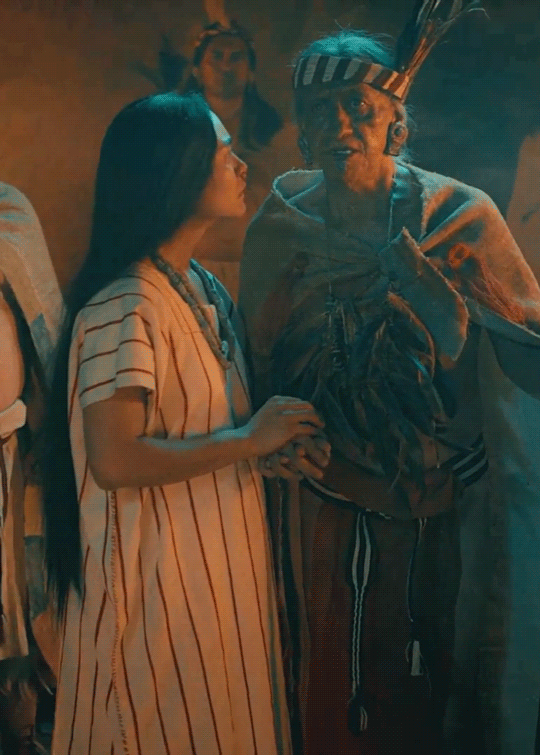
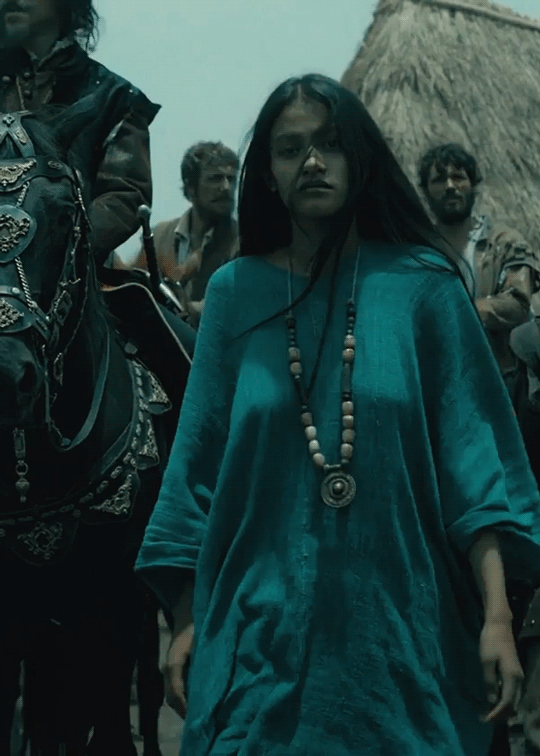
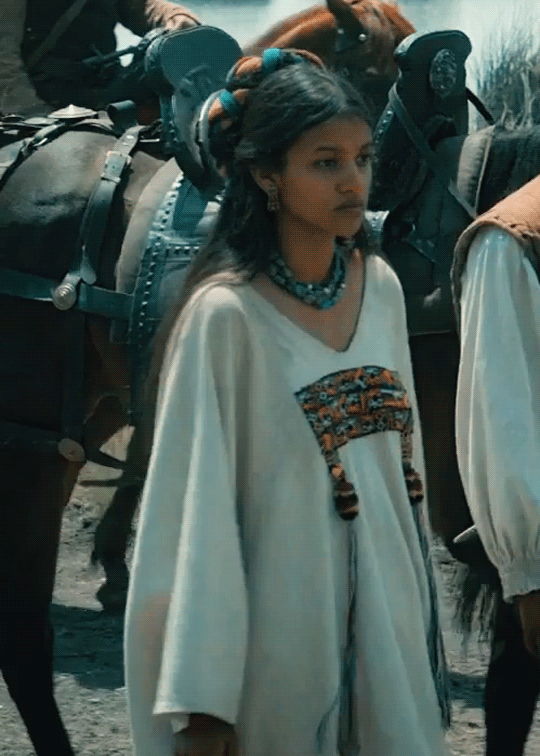





Hernán - random native costumes
#Hernán#hernanedit#perioddramaedit#perioddramasource#onlyperioddramas#costumesource#costumeedit#cinemapix#cinematv#filmtv#tvedit#native costume#mesoamerica#aztecs#tlaxcalans#tlaxcaltecs#hernan#have no idea how much historically accurate these costumes#but they are beautiful#yes i like marina and luisa
321 notes
·
View notes
Text

Stone Statue from Tlaxcala, Mexico dated between 1000-1500 on display at the Weltmuseum in Vienna, Austria
The nose jewellery on the figure indicates his extremley elevated rank. Similar figures were excavated from Tula, once the capital of the Toltec Empire and home of the legendary ruler Quetzalcoatl. The Aztecs, Tlaxcaltecs and other Mesoamerican states revered and collected objects from the Toltecs and copied the Toltec style in their own art.
Photographs taken by myself 2022
56 notes
·
View notes
Photo

Lienzo de Tlaxcala / History of Tlaxcala: it is an illustrated codex produced in the second half of the sixteenth century, at the request of the town council of Tlaxcala. The manuscript highlights the religious, cultural, and military history of the Tlaxcaltec people. The aim of this type of documents was to claim favours and honours from the king, by means of highlighting the alliance and friendship with the Spaniards, as well as the military victories and prominance of the indigenous froces in the process of conquering the different territories. The Tlaxcaltec people were one of the indigenous people of America that were most favoured by the imperial elites, being privileged and elevated to the status of european nobility.
LAW XXXIX
D. Felipe II in Poblete on April 16, and in Zaragoza on March 25, 1585. That the viceroys of New Spain honour and favour the Indians of Tlaxcala and their city and republic.
“Considering that the Indians of Tlaxcala were the first to receive the Holy Catholic Faith in New Spain, and they gave us obedience, and since the viceroys call them for burials, honours, and funerals of princes, reviews, aid and assitance in the needs that arise, and other public acts: It is our will, and we command the viceroys, that they have particular care to honour and favour them, and to call them on the occasions of our real service, and that they shall take much care of their city and republic, so that others may see the mercy we give them and serve us with the same fidelity”.
“A documented fact is that the Spaniards considered them [tlaxcaltecas] as allies in the conquest of the Mexica Empire. The Royal Decree of the Emperor Charles V in February 1537, in addition to calling the Tlaxcalteca "cousins” of his [the Emperor] (exclusive protocolar prerogative for the Spanish high nobility), praises their loyalty and tenacy to Cortés. It is a historical fact that the totality of the Tlaxcalan population was elevated to blood nobility (hidalguía) as a reward for their merits and services, as befits conquistadors" (Corona Páez, 2002)
For whatever reason the image appears blurry, but when accessing through my tumblr it improves a lot, it can also be enlarged.
#mexico#tlaxcala#history#spain#tlaxcaltecas#historia#españa#america#lienzo de tlaxcala#tlaxcalan codex#sorry for the shitty translations
17 notes
·
View notes
Note
How far north did the Aztec empire go? My grandfather is from Durango, Mexico and so my family has always had notion we were Mexica (since those ancestry tests are such weird nonsense).
This is about the maximum extent of the Triple Alliance. They never got anywhere close to Durango. https://en.wikipedia.org/wiki/Aztec_Empire#/media/File:Aztec_Empire_1519_map-fr.svg
That being said, Uto-Aztecan languages are found in West Mexico. It's likely they shared a common origin with the Mexica, Acolhua, Tlaxcalan, etc. Except the ancestors of these West Mexican groups traveled west/southwest rather than east/southeast. And they probably came from the Bajio region of north-central Mexico, not the American Southwest.
24 notes
·
View notes
Text

The Aztec Empire or the Triple Alliance (Classical Nahuatl: Ēxcān Tlahtōlōyān, [ˈjéːʃkaːn̥ t͡ɬaʔtoːˈlóːjaːn̥]) was an alliance of three Nahuaaltepetl city-states: Mexico-Tenochtitlan, Tetzcoco, and Tlacopan. These three city-states ruled that area in and around the Valley of Mexico from 1428
The alliance waged wars of conquest and expanded after its formation. The alliance controlled most of central Mexico at its height, as well as some more distant territories within Mesoamerica, such as the Xoconochco province, an Aztec exclave near the present-day Guatemalan border. Aztec rule has been described by scholars as "hegemonic" or "indirect".[6] The Aztecs left rulers of conquered cities in power so long as they agreed to pay semi-annual tribute to the alliance, as well as supply military forces when needed for the Aztec war efforts. In return, the imperial authority offered protection and political stability and facilitated an integrated economic network of diverse lands and peoples who had significant local autonomy.
Aztec religion was a monistic pantheism in which the Nahua concept of teotl was construed as the supreme god Ometeotl, as well as a diverse pantheon of lesser gods and manifestations of nature. The popular religion tended to embrace the mythological and polytheistic aspects, and the empire's state religion sponsored both the monism of the upper classes and the popular heterodoxies.
The empire even officially recognized the largest cults such that the deity was represented in the central temple precinct of the capital Tenochtitlan. The imperial cult was specifically that of the distinctive warlike patron god of the Mexica Huitzilopochtli. Peoples were allowed to retain and freely continue their own religious traditions in conquered provinces so long as they added the imperial god Huitzilopochtli to their local pantheons.
By the reign of Ahuitzotl, the Mexica were the largest and most powerful faction in the Aztec Triple Alliance.
Building on the prestige the Mexica had acquired over the course of the conquests, Ahuitzotl began to use the title "huehuetlatoani" ("Eldest Speaker") to distinguish himself from the rulers of Texcoco and Tlacopan. The alliance still technically ran the empire. But the Mexica Emperor now assumed nominal if not actual seniority.
Ahuitzotl was succeeded by his nephew Moctezuma II in 1502. Moctezuma II spent most of his reign consolidating power in lands conquered by his predecessors.In 1515, Aztec armies commanded by the Tlaxcalan general Tlahuicole invaded the Purépecha Empire once again.The Aztec army failed to take any territory and was mostly restricted to raiding. The Purépecha defeated them and the army withdrew.
Moctezuma II instituted more imperial reforms.The death of Nezahualcoyotl caused the Mexica Emperors to become the de facto rulers of the alliance. Moctezuma II used his reign to attempt to consolidate power more closely with the Mexica Emperor.He removed many of Ahuitzotl's advisors and had several of them executed. He also abolished the quauhpilli class, destroying the chance for commoners to advance to the nobility. His reform efforts were cut short by the Spanish Conquest in 1519.
The Spanish expedition leader Hernán Cortés landed in Yucatán in 1519 with approximately 630 men (most armed with only a sword and shield).
Eventually, the Spanish-led army assaulted the city both by boat and using the elevated causeways connecting it to the mainland. The attackers took heavy casualties, although the Aztecs were ultimately defeated. The city of Tenochtitlan was thoroughly destroyed in the process. Cuauhtémoc was captured as he attempted to flee the city. Cortés kept him prisoner and tortured him for a period of several years before finally executing him in 1525.
7 notes
·
View notes
Note
1/ Looking at the racist taggs discussion, I'm left with the impression that since accusations of Child Porn(CP) didn't work against AO3 due to there being a legal definition of CP in the USA, antis are now jumping to the legitimate racism in fandom problem which since to my knowledge doesn't have a clear definiton so it can be used to hit whatever you don't like.
2/ I mean I'm from Latin America should I report a COCO fic as racist due to it being written in English when the action takes place in Mexico? Should Emperor's New Groove fics only be written in Quechua? Is it racist if I write an AU where a noble Tlaxcaltecan( native Tlaxcalan's were allowed to keep titles after Mexico's conquest) falls in love with a Maya woman in the 1500 Mexico? Both are POC according to USA standards. You'd need a team of experts from each country to enforce the tag.
I don't think it's purely an anti tactic, but yes. AO3's blocking features they have in development are a much better bet for dealing with problems on the archive.
45 notes
·
View notes
Photo

Spain and Tlaxcala // España y Tlaxcala.
Spain said: “are you ok?”
Eng:
No people in Mesoamerica knew about horses, they even came to think at first that the Spaniards were men-beasts, since they saw the rider and the horse as one. During the battles of the Spanish against the Tlaxcalans, they beheaded a mare and showed its head in Tlaxcala to deny that the Spanish were gods. Later, after the fall of Tenochtitlán, the Tlaxcalans obtained the privilege of riding a horse, and in fact by accompanying the Spanish to northern Mexico and Central America I have to assume that some must have gone on horseback. And well, it's literally Spain teaching Tlaxcala to ride a horse. Although in the heat of the battle he was able to approach and wound them without fear, it was still an unknown animal that he was not used to.
Esp:
Ningún pueblo de Mesoamérica conocía los caballos, incluso llegaron a pesar en un principio que los españoles eran hombres-bestias, pues veían al jinete y al caballo como uno solo. Durante las batallas de los españoles contra los tlaxcaltecas, estos decapitaron a un yegua y mostraron su cabeza en Tlaxcala para desmentir que los españoles eran dioses. Posteriormente, después de la caída de Tenochtitlán, los tlaxcaltecas obtuvieron el privilegio de montar a caballo, y de hecho al acompañar a los españoles al norte de México y a Centroamérica yo he de suponer que algunos debieron ir a caballo. Y bueno, literalmente es España enseñándole a Tlaxcala a montar a caballo. Aunque en el calor de la batalla pudo acercarse y herirlos sin miedo, no dejaba de ser un animal desconocido al que no estaba acostumbrado
50 notes
·
View notes